
The Lost Generation. Despite being over a hundred years ago, The Lost Generation has many similarities to today. Growing up as a young individual in this period meant facing war, a pandemic, harsh economic times, and changing social conditions. World War I was brutal, mobilizing over 70 million people, killing 8.5 million, wounding 21 million, and causing 2 million soldiers to die of disease. The Spanish Flu pandemic of 1918 to 1920 was ruthless, with some estimates placing the death toll between 17 to 50 million, while others claim as many as 100 million died. After the war and the pandemic, the world faced economic turmoil, leading to the Great Depression in the 1930s, resulting in high unemployment rates, poverty, and a general sense of hopelessness. Despite these hardships, popular culture began to rise in the form of early cinema and magazines as people sought distraction from their harsh reality. Women gained the right to vote in 1920, and new employment opportunities for unmarried women widened, many of whom were left widowed due to the war. This era saw the rise of a new type of young woman in pop culture, known as the flapper, recognized for rebelling against previous social norms and embodying a more reckless and party-going attitude. The Lost Generation is remembered today for its resilience and ability to survive a harsh and challenging period. Some say it could provide insight into modern or future periods.

The Greatest Generation. This generation, also known as the World War II Generation, is remembered for its heroism, technological innovation, and prosperity. The youth during this time would grow up with many advancements becoming popular and normalized, like the radio, telephone, and automobile. It was a significant period for culture and entertainment in America. Literature, arts, music, and cinema flourished during this period, known as the Golden Age of Hollywood. Comic books saw the birth of huge franchises like Superman and Batman. In the music industry, jazz, blues, gospel music, folk music, and swing jazz became the main genres. The radio influenced many Americans during this period, as millions would tune in and listen to President Roosevelt's famous Fireside Chats and learn about the news in an exciting way. Sixteen million Americans served in World War II, the majority being members of the Greatest Generation. 38.8% were volunteers, 61.2% were draftees and would serve the average length of 33 months. There were approximately 671,000 casualties in the United States. As of 2023, almost 120,000 of the Americans who served in this war are still alive today.

The Silent Generation. The Silent Generation grew up witnessing the fall of Nazism and the rise of their new enemy, communism. When the children of this era began coming of age after World War II, they faced a devastated social order following World War II. The Soviet Union betrayed America's post-war agreements, and the global powers would face off for the next 50 years. Unlike the previous generations who fought to change the system, the Silent Generation was about working within the system, keeping their heads down, and working hard. The generation's influences in its formative years included a broad category. It included the Golden Age of radio, the rise of trade unions, the development of transatlantic flight, and the discovery of penicillin. Silents tended to marry and have children young, and their attitude of taking no chances was criticized by future, more radical generations, such as the Baby Boomers.
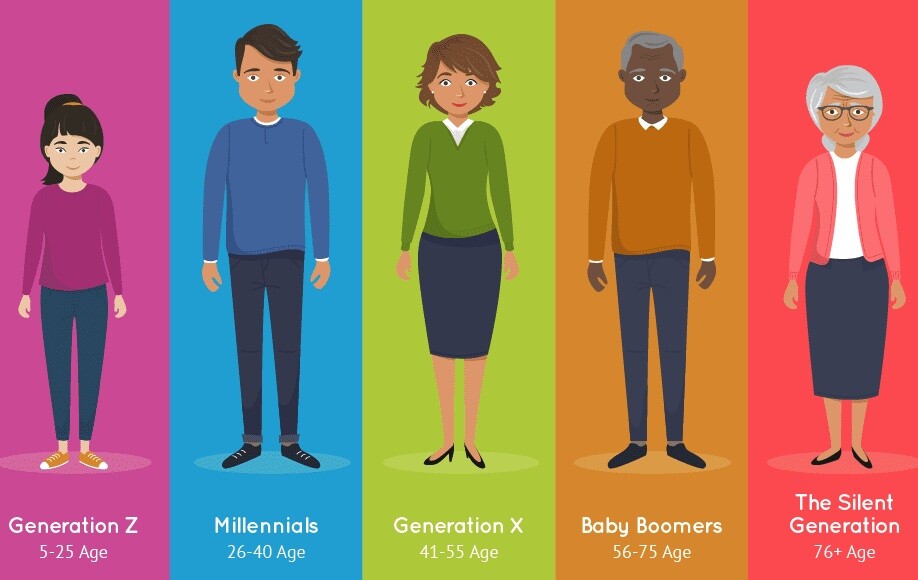
The Baby Boomers. Possibly the most famous modern birth generation and one of the most active periods in American history, the Boomers of the '40s, '50s, and '60s were known for their high birth rates, with 76 million births taking place during this period. It was due to a robust, post-war economy in which Americans felt confident they would be able to support a large number of children. Boomers influenced the economy as a core marketing demographic for products tied to their age group. The products ranged from toys to records. On top of this, many items previously deemed luxurious, such as laundry machines, dishwashers, refrigerators, and telephones, entered mass production for the average consumer. The average American could live like the upper class from the previous generation. Technological advances made before, during, and after the war, such as plastics, television, magnetic tape, transistors, integrated circuits, and lasers, played a massive role in the tremendous improvements in the typical standard of living. With this extended period of optimism came a cultural rush, especially in the music industry, where the Beatles, Bob Dylan, the Rolling Stones, and many other artists and bands became extremely popular. Not everything was sunshine and rainbows, of course, as it was a period where significant political discussions around topics like the sexual revolution, civil rights, nuclear weaponry, ethnocultural diversity, and environmental protection became popular and heavily debated. It was because this generation was a lot more radical. Many people during this time had different perspectives and favored more left-leaning social causes in almost every direction, strongly opposing existing conservative, traditionalist thinking that plenty of others still had. Many of these political disagreements resulted in protests that were becoming increasingly violent, especially as the Vietnam War lingered on. The United States would slowly become more divided, and government distrust would rise in the following generations.
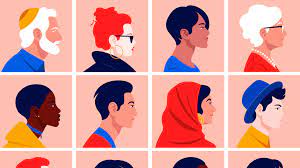
Generation X: This generation is often called the "Latchkey Generation". The term stems from the children of this generation returning from school to an empty home and needing a key to let themselves in, a result of living in an era of free-range parenting, increasing divorce rates, increased maternal participation in the workforce, and widespread availability of childcare options outside the home. Young adults of this period were dubbed the "MTV Generation," sometimes characterized as slackers, cynical, and disaffected. The baby boom era of the last generation was met with declining birth rates during this generation, partially due to the birth control pill introduction in 1960 and abortion legalization in 1973. However, demographic changes brought about by the 1965 Immigration Act partially offset the declining birth rates of Americans already living there. It further contributed to making Gen X in America more culturally and ethnically diverse than America had ever been. Gen X music saw many alternative rock, hip-hop, punk, post-punk, and heavy metal bands rise in popularity. Technological innovation boomed during this period, with home computing manufacturers like Apple, Commodore, and Atari taking to the scene with their offerings. Video games became a booming industry during the 1970s and 1980s, while arcades became widely successful countrywide. At the same time, Nintendo and Atari introduced home consoles. Compared to Boomers, Gen Xers were far more educated, as college enrollment was more popular. Individualism and entrepreneurialism became some of the most defining traits of Gen X, as the collective generation would go on to produce Google, Wikipedia, Amazon, and YouTube towards the '90s and early 2000s.
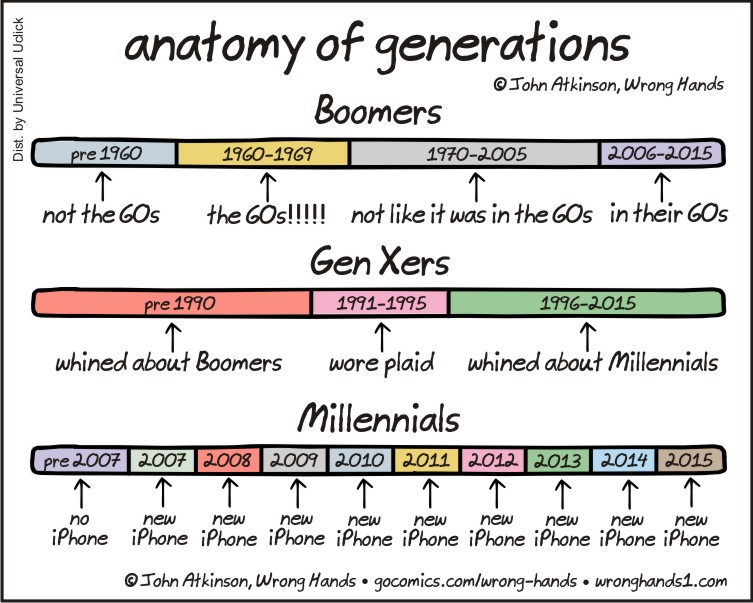
Generation Y (Millennials): Millennials were the first to grow up with the internet, mobile technology, and social media. It is the first global generation connected to the entire world. However, they are also described as the unluckiest generation due to their slower economic growth since entering the workforce than any other generation in history. As well, millennials get weighed down by student debt and childcare costs. Millennials were born at a time of declining fertility rates worldwide. Thus, this generation is having fewer children than their predecessors. Young people of the 2010s were often criticized for having less sexual intercourse compared to their predecessors when they were at the same age. In 2010, the unemployment rate in the United States reached a record low at 19%, and these economic difficulties have led to a dramatic increase in youth poverty, unemployment, and a large number of them living with their parents. Millennials are also less likely to be religious than their predecessors, though many identify as spiritual. Millennials experienced 9/11, which changed American culture and began the war on terrorism. That's not to say it's all bad for them since they gained digital fluency, diverse perspectives, and a strong sense of social consciousness due to globalization. Millennials are active socially and politically and not afraid to use their voice. And despite the previously mentioned economic troubles, eight in 10 Millenials feel confident in their finances, portraying their generally positive outlook in a more complicated world.
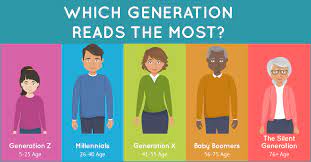
Generation Z (Zoomers): Zoomers are very similar to Millennials, but there are some key differences. While Millennials were exposed to the internet and smartphones during their formative years and witnessed the entire world change, forced to adapt quickly, Zoomers were born into it. People born during this period have grown up with a rise of social justice movements, a vicious new form of American politics with the rise of Donald Trump, the Black Lives Matter protests, a new pandemic, and lockdowns that prevented most of them from experiencing a large part of their high school or college lives. On top of that, there's an ever-growing attention and dopamine economy, with apps like YouTube and recently TikTok transforming not just how they consume information - but there are algorithms also transforming what information the public gets. Even simple and seemingly silly things like memes, started by Millennials as jokes, have become tools to spread and popularize ideas. Individualism defines the Zoomer spirit, as they have again returned to the entrepreneurial spirit of Gen X because the internet, freelancing, and gig economy work are transforming jobs. The pandemic transformed where jobs are run–at home rather than in an office. Many of these changes, while seemingly insignificant, have a tremendous impact on their generation's culture. Zoomers are also the most diverse generation in American history, as estimates indicate that over half will be part of a minority ethnic group by 2020. Most Zoomers will obtain a university degree and enter the workforce later as they stay in education for longer.

Generation Alpha: As of now, the characteristics of Generation Alpha are largely speculative, but here's what we know thus far: Generation Alpha is the first generation to be born entirely in the 21st century. They will be the most technologically immersed generation yet. They are born and growing up with tablets and smartphones as part of their lives. They will likely be the most formally educated generation in history. In addition, they will be the wealthiest. They are the children of Millennials, and like their parent's generation, they are growing up in a more diverse and inclusive world. They are likely to be more aware of global issues from a young age due to their exposure to the internet.
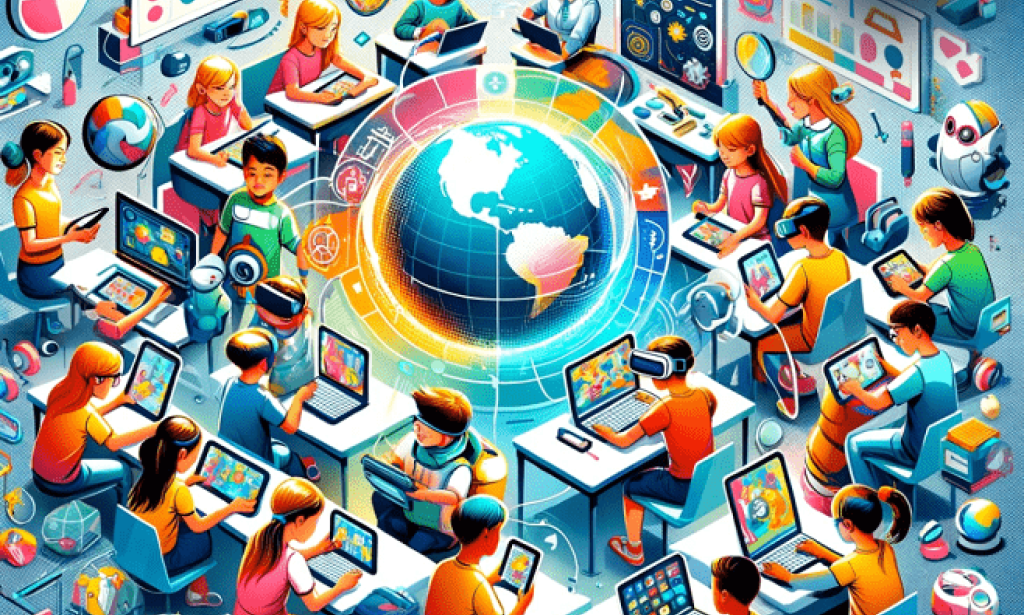

You must be logged in to post a comment.